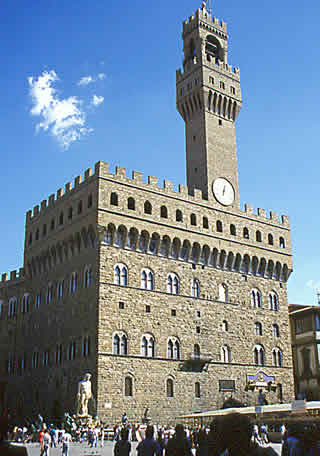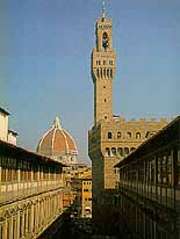Firenze - Palazzo Vecchio
Palazzo Vecchio o Della Signoria

In 1299 after Christ the City of Florence charged Arnolfo di Cambio to build "Palazzo Vecchio", who in the city has already realised the projects for Santa Croce and for the Cathedral.
The intervention was forecasting the use of the area going from the church of San Piero Scheraggio up to "Palazzo degli Uberti", "Palazzo dei Fanti" and "Palazzo dell'Esecutore di Giustizia" ("Palazzo of the judiciary executor). The building, born to welcome the Priori, representatives of the Major Arts, and which from the 16th century will be also known as "Palazzo della Signoria", takes its inspiration from the examples of the typical communal edifices of the region, but also from the Castle of Poppi, where probably the same Arnolfo di Cambio worked during the last decade of the 13th century.
The castle, wanted by the Conti Guidi and built between Bibbiena and Campaldino shows, in fact, important similarities with the "Palazzo Vecchio" of Florence, in the floor plan position of the tower as well as in the revetment of the access balcony;
However, on the strong parallelepiped constituting the core of the edifice, Arnolfo di Cambio develops an access balcony strongly overhanging that is at the same time the basis on which is established, in a position asymmetrical with respect to the entire complex, the 94 metres high tower.

The external superficies of the "Palazzo della Signoria", covered by the rustic studded extracted from the cave on the hill of Boboli, are covered by two orders of twin windows, underlined by frames and decorated on the highest part by a series of arches which function is to support the overhang towards the external part of the superior access balcony.
Thanks to the advancement of the track way with respect to the facade, it is therefore possible to open the machicolations, vulgarly called "manholes", through which one can throw on eventual aggressors oil and rocks.
The spaces between the various sustaining arches have been covered by frescoes repetitively after 1343 after Christ with the red cross of the captain of the people, the stemma of Florence, the two intersecting keys of the Pope and other heraldry symbols of the Republic of Florence.
The tower of Palazzo Vecchio, which hosts the room of the "Albergaccio", where will be imprisoned Cosimo the Old in 1433 after Christ and Girolamo Savonarola in 1498 after Christ, was finished around 1308 after Christ with a rise on which is leaning a sphere of bronze and the "marzocco", one of the most antique symbol of Florence, which represents a lion with a lily.